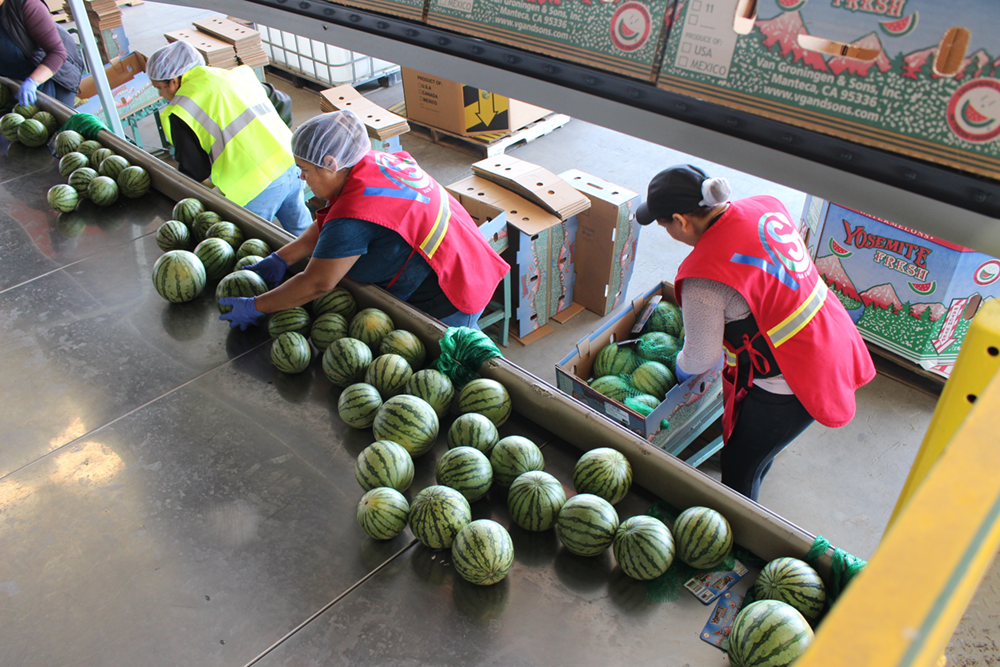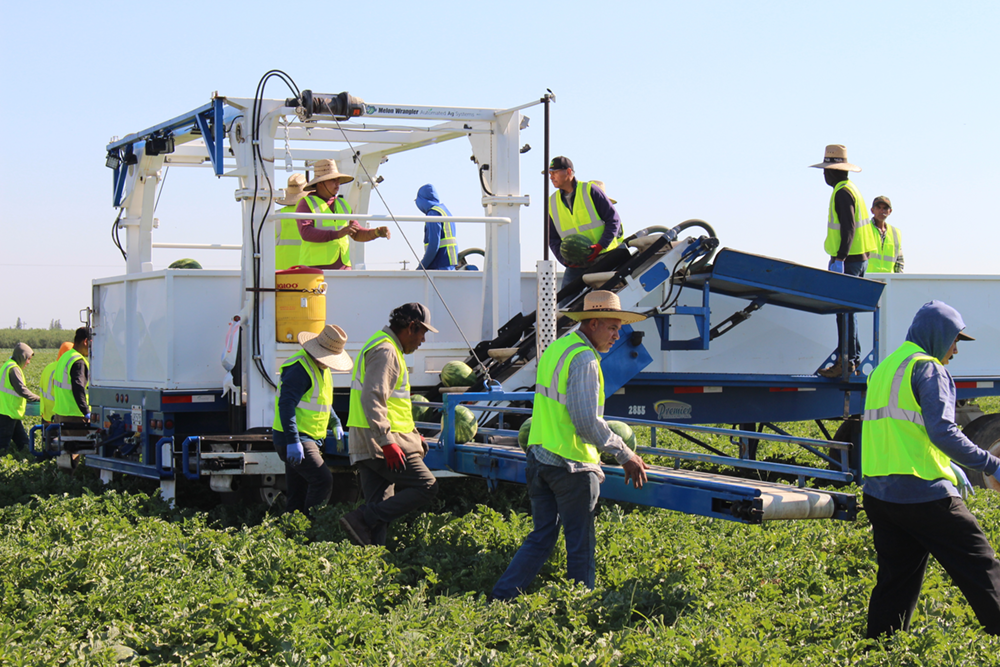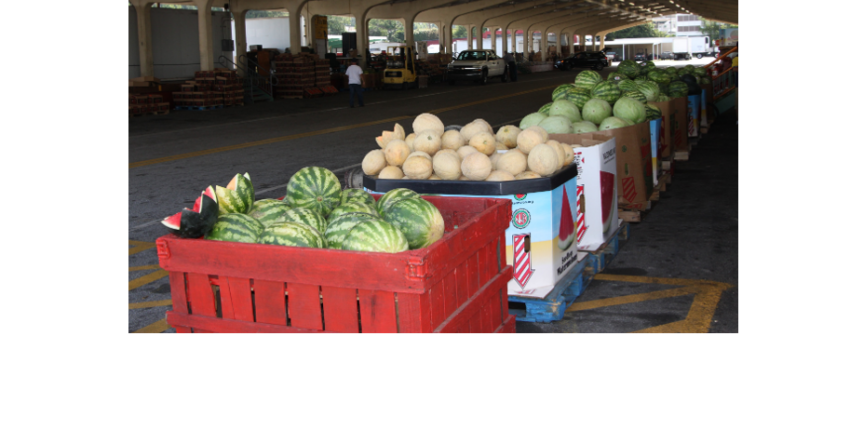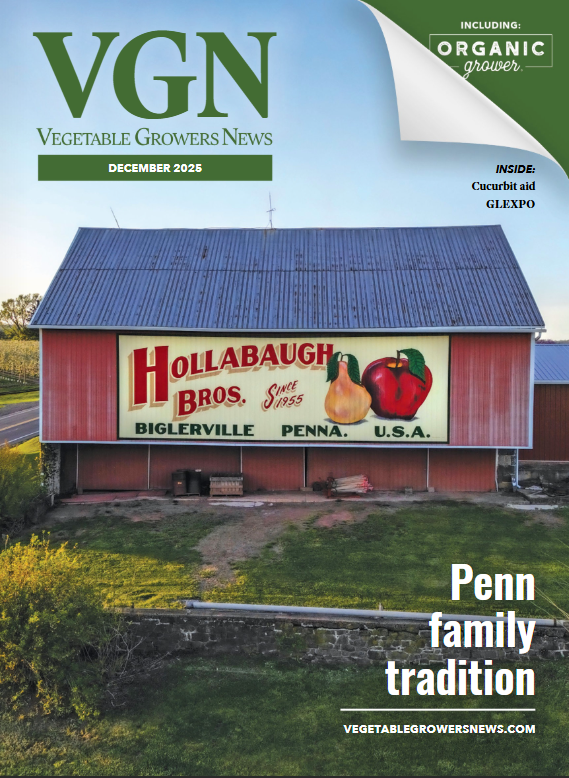Jun 28, 2024Melon growers prepare for the holiday
California watermelons, cantaloupes, honeydews and mixed melons will arrive in grocery stores in time for the Independence Day holiday, an important marketing window melon growers and shippers strive to meet each season.
“It is critical for growers to supply melons, especially watermelons, to retailers in time for the July Fourth holiday,” said Bryan Van Groningen of Van Groningen and Sons, a grower, packer and shipper of watermelons based in Manteca. “Much of the summertime watermelon demand is dependent on family consumption and people having parties and picnics.”
Van Groningen, whose family grows and ships seeded, seedless and miniature watermelons to retailers in California and other states, said crews began harvesting watermelons last week near Manteca.
Early-season miniature watermelons are packed under the Yosemite Fresh label and sold in supermarkets in California and across the West. Photo by Christine Souza.
Melon season has shifted to the San Joaquin Valley as harvest wraps up in the Southern California desert in the Imperial Valley and in Yuma, Arizona. Harvest in the San Joaquin Valley is expected to continue through October and resume in the desert from October to December.
In mid-March, when planting typically begins in the San Joaquin Valley, Van Groningen said wet weather and soggy field conditions interrupted ground preparation and delayed planting.
“This year, we had to wait to plant until the third week of March because it was too wet and cold,” he said. “Due to the delay, we only got a chance to plant about two-thirds of our acres for the early marketing window, so our volume is probably going to be down a little.”

Because the late-season melon market is usually not as lucractive, Van Groningen said he was concerned that he would not be able to supply the volume of watermelons he initially planned for June and July. With the supply of watermelons short right now, he noted, “the price and the demand are very good.”
“I’m kind of afraid for that August to September market, but we’ll see what happens,” he said, adding he hopes the market will continue to be strong in July. “August is when demand starts to slow because there are more watermelons available.”
Producing some 100 million pounds of watermelons annually, Van Groningen said about 80% of the family’s watermelons is shipped to retailers in California, with additional volume distributed in Nevada, Oregon, Washington, Utah and Colorado. He said he anticipates a grower price of $450 to $500 per ton, which he described as about average for watermelons.
While figures are not yet available for the San Joaquin Valley watermelon crop, prices for the Southern California desert region are running below last year’s pace, according to data from the U.S. Department of Agriculture Agricultural Marketing Service.
As of mid-June, a 45-count carton of seedless watermelons was selling for $154 to $189, while the 60-count carton went for $105 to $155. This was a slight drop from the 2023 price, according to USDA.
Brawley-based farmer Joe Colace of Five Crowns Marketing, which grows, packs and ships watermelons, cantaloupes, honeydews and specialty melon varieties, said he expects to finish melon harvest in the Imperial Valley in about a week.

“There’s just a little bit of an oversupply here in the desert, but it has been a very nice year for quality,” Colace said. “Our sugar, or soluble solid levels, seem to be above average.”
When harvest began in the desert region in early May, Colace said many cantaloupe and honeydew growers reported smaller sizes and less production due to wind and below-average temperatures through late February and into April. He noted that he “saw size and production pick up in the middle part of June.”
“One thing about cooler-than-normal temperatures: Quality typically tends to be a little better because you don’t have nearly the stress on the plant,” he said.
Colace said he is pleased with two new specialty melons—the Picasso and Picasso Sunrise, available from late May to early July. The Japanese-origin Picasso variety is a white-flesh melon with a high level of sugar. The Picasso Sunrise has similar traits but with salmon-color flesh. Colace said he worked with seed company breeders to develop the new varieties that are exclusive to Five Crowns Marketing.
“We try and develop varieties that check off all of the critical boxes for delivered product to the stores, and Picasso and Picasso Sunrise, right now, are checking all the boxes,” Colace said.
In the Imperial Valley, Colace relies 100% on water supplied by the Colorado River. “There seems to be not an abundance of water, but water is available, and that has taken some of the pressure off all the respective growing areas,” he said.
Growers in all regions tend to agree that costs to grow, pack and ship melon crops have escalated.
This includes Stanislaus County farmer Matt Maring, a partner in Patterson-based T&M Farms, which grows watermelons, cantaloupes, honeydews and mixed melon varieties. He estimated the cost to grow watermelons is about $4,000 an acre, while growing and packing can run about $12,000 an acre.
“If you don’t have historical sales and relationships with chain stores, you are crazy to go plant and pray that you have a market,” he said.
Maring said he expects to harvest melons from early July to November. The westside region had good growing conditions this spring with mild temperatures, Maring said, noting he observed no pest or disease issues. In addition, the region had more water this year.
Much of Maring’s water is supplied by the federal Central Valley Project, which received 40% of requested supplies this year. The number of acres he planted this year was not based on water availability but demand from the company that markets his crop.
As the season progresses, Maring said there may be a surplus of melons on the market. “It’s definitely setting up that way,” he said.
Due to his location, Maring said it is not always easy to supply melons to customers by July 4. But he said he is impressed with melon quality this year, adding flavor is “ridiculously good.”
“I do a lot of shopping at my house,” he said, “and when stores have six pallets of watermelons at the store entrance at $6 or $7 each, that sparks interest.”
— Christine Souza is an assistant editor of Ag Alert.
This article was originally published by the California Farm Bureau Federation and permission was granted for its use.

















